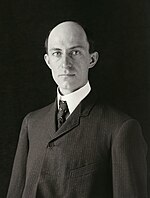The Wright brothers, Orville Wright (August 19, 1871 – January 30, 1948) and Wilbur Wright (April 16, 1867 – May 30, 1912), designed, built, and flew the first controlled, powered, heavier-than-air airplane on December 17, 1903.[1] They had been experimenting for many years with gliders and other vehicles before their first powered flight. They are also known for making the first way to steer an airplane. They designed the aircraft in Dayton, Ohio, and their first test flight was in Kitty Hawk, North Carolina.
Orville Wright | |
|---|---|
 Photo: 1903 | |
| Born | August 19, 1871 |
| Died | January 30, 1948 (aged 76) |
Wilbur Wright | |
|---|---|
 Photo: 1903 | |
| Born | April 16, 1867 |
| Died | May 30, 1912 (aged 45) |
Before building airplanes
changeThe Wrights grew up in Dayton, Ohio. They were sons of a minister.[2] There were many books in their house, and they were encouraged to ask questions and discover whatever they thought was interesting. Sometimes their father would ask them to argue for a topic, then switch sides and argue for the opposite point of view.
They went to high school, but did not go to college; they started a newspaper instead.[3] After that, they started a shop to build and repair bicycles.[4]
Learning how to fly
change“By the 1890s, the Wrights were interested in flight, especially the gliders of Otto Lilienthal. They started working on making airplanes in their bicycle shop.[5] They thought controlling a plane was one of the big problems of flight. Lilienthal and others had been killed when they could not control their aircraft. The Wright brothers fixed the problem by inventing control surfaces, such as a rudder that would work in the air. They built wings that could be twisted a little[6] and moved up and down slightly, to control flight. They called this steering system wing-warping.
From 1900 to 1902, they built gliders in Dayton and tested them in Kitty Hawk, where there were strong and steady winds. They also made small versions of the wings and built a wind tunnel for model airplanes to test how well different wing shapes would lift an airplane.”
Flying
changeIn 1903, they built a powered airplane that had propellers and a small engine. The Wright Flyer airplane first flew successfully on December 17, 1903, near Kitty Hawk, North Carolina.[2] This was the first time people ever flew a powered airplane they could control. Before that, people flew in balloons or gliders or, for a very short time, in planes they could not control. The two brothers continued to make changes to their design and had a very good plane by 1905.
The Wright Brothers kept their discovery largely secret for a couple of years, until they showed it to the world in 1908[7] (They had filed a patent on their steering system March 23, 1903.)[8]
After that, they started a company to build airplanes. They had a patent war with Glenn Curtiss, filing lawsuits against each other over who really invented the airplane steering system. The Wrights believed that Curtiss' aileron system was too similar to their own steering system and that he had copied them. During the patent war, Wilbur died. Orville continued working to keep his reputation as the first man to fly. Later he sold the airplane company and became an elder statesman of aviation. He died in 1948.
References
change- ↑ The Fédération Aéronautique Internationale is the standard setting and record-keeping body for aeronautics and astronautics worldwide. They officially said the Wright brothers flight was "the first sustained and controlled heavier-than-air powered flight".
- ↑ 2.0 2.1 "Telegram from Orville Wright in Kitty Hawk, North Carolina, to His Father Announcing Four Successful Flights, 1903 December 17". World Digital Library. 1903-12-17. Retrieved 2013-07-22.
- ↑ What Dreams We Have
- ↑ "The Van Cleve Bicycle that the Wrights Built and Sold". U.S. Centennial of Flight Commission. Archived from the original on 2012-10-08. Retrieved 2009-05-22.
- ↑ "Wilbur Wright Working in the Bicycle Shop". World Digital Library. 1897. Retrieved 2013-07-22.
- ↑ The Bishop's Boys, Tom D. Crouch, 2003, W.W. Norton & Co., p. 201. ("Wing-warping").
- ↑ "L'Aerophile," August 11, 1908, quoted in Crouch, p. 368. Demonstration flights were made Aug. 8-15, 1908. (Crouch, p. 366-7.).
- ↑ Wright, Orville, "Flying-Machine", U.S. Patent 821393, retrieved 2010-03-19[permanent dead link]